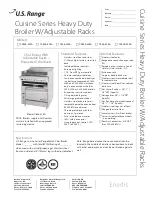
16
| English
Noise/Vibration Information
GSR 12V-15 FC GFA 12-X GFA 12-B GFA 12-E GFA 12-W
Noise emission values determined according to
EN 62841-2-1
for the adapter GFA 12-B.
Noise emission values determined according to
EN 62841-2-2
for the rest of the adapters listed here.
Typically, the A-weighted noise level of the power tool is:
Sound pressure level
Sound power level
Uncertainty K
Wear hearing protection!
dB(A)
dB(A)
dB
79
80
3
–
–
3
–
–
5
–
–
3
–
–
3
Vibration total values a
h
(triax vector sum) and uncertainty K determined according to
EN 62841-2-1
for the adapter GFA 12-
B.
Vibration total values a
h
(triax vector sum) and uncertainty K determined according to
EN 62841-2-2
for the rest of the ad-
apters listed here.
Drilling into metal:
a
h
K
m/s
2
m/s
2
2.5
1.5
–
–
2.5
1.5
–
–
–
–
Screwdriving:
a
h
K
m/s
2
m/s
2
2.5
1.5
2.5
1.5
–
–
2.5
1.5
2.5
1.5
The vibration level and noise emission value given in these
instructions have been measured in accordance with a
standardised measuring procedure and may be used to com-
pare power tools. They may also be used for a preliminary
estimation of vibration and noise emissions.
The stated vibration level and noise emission value repres-
ent the main applications of the power tool. However, if the
power tool is used for other applications, with different ap-
plication tools or is poorly maintained, the vibration level
and noise emission value may differ. This may significantly
increase the vibration and noise emissions over the total
working period.
To estimate vibration and noise emissions accurately, the
times when the tool is switched off or when it is running but
not actually being used should also be taken into account.
This may significantly reduce vibration and noise emissions
over the total working period.
Implement additional safety measures to protect the oper-
ator from the effects of vibration, such as servicing the
power tool and application tools, keeping their hands warm,
and organising workflows correctly.
Fitting
u
Remove the battery from the power tool before carry-
ing out work on the power tool (e.g. maintenance,
changing tool, etc.). The battery should also be re-
moved for transport and storage.
There is risk of injury
from unintentionally pressing the on/off switch.
Charging the battery
u
Use only the chargers listed in the technical data.
Only
these chargers are matched to the lithium-ion battery of
your power tool.
Note:
The battery is supplied partially charged. To ensure
full battery capacity, fully charge the battery in the charger
before using your power tool for the first time.
The lithium-ion battery can be charged at any time without
reducing its service life. Interrupting the charging process
does not damage the battery.
The lithium-ion battery is protected against deep discharge
by the "Electronic Cell Protection (ECP)". When the battery
is discharged, the power tool is switched off by means of a
protective circuit: The application tool no longer rotates.
u
Do not continue to press the On/Off switch after the
power tool has automatically switched off.
The battery
can be damaged.
Removing the battery (see figure A)
To remove the battery
(5)
, press the release button
(4)
and
pull the battery downwards out of the power tool.
Do not
use force to do this.
Changing the tool
Inserting the application tool (see figure B)
Insert the application tool all the way into the mounting
(1)
.
Fitting the adapter (see figure C)
Remove the application tool.
Insert the adapter into the mounting
(1)
. Turn the locking
ring
(14)
until it audibly engages.
1 609 92A 53H | (23.06.2020)
Bosch Power Tools
Autogoods “130”
130.com.ua
















































